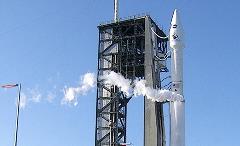Introduction to Propellant Gauging Online

- New practical online course essential to any practicing or aspiring Propulsion Engineer
- All students will receive an AIAA Certificate of Completion at the end of the course
Overview
Prediction of remaining propellant for spacecraft in flight is critical in many cases, from low orbit (like GEO ComSat, GPS, Earth Observation satellites, etc.) to space exploration missions. Increases in demand for data flow capacity have led to the development of larger and more powerful satellites. When such systems are utilized to full capacity, the net annual revenues per vehicle may be in the millions of dollars. Accurate knowledge of the propellant remaining is critical for the planning and executing of space missions.
There are more than 300 GEO satellites now in flight. Knowledge of how much propellant remains is very important from different points of view: business planning, ordering new satellites, moving to a new orbital slot, etc. The phasing of orbital replacements on time in the telecommunications industry will maximize revenue and reduce the probability of occupying an orbital slot by a disabled satellite which has run out of propellant.
Currently, three methods of propellant estimation are commonly employed to evaluate remaining propellant for a spacecraft in flight:
- Book-keeping (BK) method, based on the calculation of used propellant
- Pressure-Volume-Temperature (PVT) method, based on the ideal gas law
- Thermal propellant gauging method, based on the measurement of heat capacity of the remaining propellant
Some of the methods, like the BK or PVT, have high accuracy at the beginning of a spacecraft mission. The high accuracy of these methods is either related to the fact that an error did not accumulate yet, like in the BK method, or due to high sensitivity of the helium (He) pressure to volume change at the beginning of life, as in the PVT method. On the other hand, some gauging methods like thermal which are not very accurate at the beginning of the mission life, become very accurate at the end of the mission life. This is due to the fact that the accuracy of thermal gauging methods increases as the propellant load decreases due to increase of temperature rise sensitivity to tank load when the tank load decreases.
This new practical course covers all of the fundamentals of propellant gauging for chemical propulsion in the space environment. Electric Propulsion propellant gauging will also be covered.
- Understand all three propellant gauging methods
- Understand the pros and cons of each method
- Understand the optimal application of each method
- Understand propellant gauging for Electric Propulsion
- See detailed Outline below
Type of Course: Instructor-Led Short Course
Course Length: 1 day
AIAA CEU's available: Yes
This course is also available on-demand.
1. The most popular designs of a propulsion system
1.1. Chemical
1.1.1. Mono-propellant
1.1.2. By-propellant
1.1.3. Single tank
1.1.4. Multiple tanks
1.2. Electrical propulsion
2. Introduction to methods of satellite propellant gauging for chemical propulsion
2.1. Book-keeping
2.1.1. Fundamentals
2.1.2. Accuracy
2.1.3. Application of the method to different propulsion systems
2.2. Pressure-Volume-Temperature (PVT)
2.2.1. Fundamentals
2.2.2. Accuracy
2.2.3. Application of the method to different propulsion systems
2.3. Thermal propellant gauging
2.3.1. Fundamentals
2.3.2. accuracy
2.3.3. Application of the method to different propulsion systems
3. Comparison of all three methods
3.1. Which, when and how to use each method or combination
4. Propellant gauging for electrical propulsion
4.1. Fundamentals
4.2. Accuracy
4.3. Problems
5. Conclusion
AIAA Training Links
For information, group discounts,
and private course pricing, contact:
Lisa Le, Education Specialist (lisal@aiaa.org)
